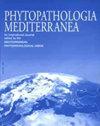Fusarium oxysporum f. sp. ginseng, a new forma specialis causing Fusarium root rot of Panax ginseng
IF 1.9
3区 农林科学
Q2 AGRONOMY
引用次数: 1
Abstract
Panax ginseng is a valuable medicinal plant which is affected by many diseases during its long cultivation period. Ginseng root rot, caused by Fusarium oxysporum, has become severe in China. This soilborne pathogen comprises many formae speciales based on host specificity. Ten representative isolates from diseased ginseng rot root showed pathogenicity on ginseng. To identify the forma specialis of the F. oxysporum strains, host range tests of three representative isolates were carried out on nine plant species. All three isolates caused severe symptoms only on ginseng, but only slight or no visual symptoms on the other eight hosts, indicating that the strains were host-specific to ginseng. Phylogenetic trees were constructed based on sequences of the translation elongation factor 1-α (EF-1α) gene, two endopolygalacturonase genes (Pg1, Pg5) and two exopolygalacturonase genes (Pgx1 and Pgx4). The ten F. oxysporum isolates from ginseng clustered into a unique group clearly separated from other formae speciales already described. Based on the host range tests and phylogenetic analyses, the isolates of F. oxysporum derived from ginseng have been identified as a new forma specialis, designated Fusarium oxysporum f. sp. ginseng. This is the first report of forma specialis of F. oxysporum on ginseng.引起人参镰刀菌根腐病的一个新变种&尖孢镰刀菌人参
人参是一种珍贵的药用植物,在长期栽培过程中受到多种病害的侵袭。人参根腐病是由尖孢镰刀菌引起的一种严重病害。这种土传病原体根据宿主的特异性包括许多不同的形式。10株有代表性的人参腐根病原菌对人参具有致病性。为了鉴定尖孢镰刀菌菌株的特殊形态,对9种植物进行了3株代表性菌株的寄主范围试验。所有三株菌株仅在人参上引起严重症状,但在其他8个宿主上仅引起轻微或没有视觉症状,表明菌株对人参具有宿主特异性。以翻译延伸因子1-α (EF-1α)基因、2个内聚半乳糖醛酸酶基因(Pg1、Pg5)和2个外聚半乳糖醛酸酶基因(Pgx1、Pgx4)序列为基础构建系统发育树。从人参中分离出的10株尖孢镰刀菌聚集成一个独特的类群,与前面所述的其他特殊类群明显分开。通过寄主范围测定和系统发育分析,确定了人参尖孢镰刀菌(Fusarium oxysporum F. sp. ginseng)为一种新的特殊菌种。本文首次报道了人参上尖孢霉的特殊形式。
本文章由计算机程序翻译,如有差异,请以英文原文为准。
求助全文
约1分钟内获得全文
求助全文
来源期刊

Phytopathologia Mediterranea
生物-植物科学
CiteScore
4.40
自引率
8.30%
发文量
28
审稿时长
6-12 weeks
期刊介绍:
Phytopathologia Mediterranea is an international journal edited by the Mediterranean Phytopathological Union. The journal’s mission is the promotion of plant health for Mediterranean crops, climate and regions, safe food production, and the transfer of new knowledge on plant diseases and their sustainable management.
The journal deals with all areas of plant pathology, including etiology, epidemiology, disease control, biochemical and physiological aspects, and utilization of molecular technologies. All types of plant pathogens are covered, including fungi, oomycetes, nematodes, protozoa, bacteria, phytoplasmas, viruses, and viroids. The journal also gives a special attention to research on mycotoxins, biological and integrated management of plant diseases, and the use of natural substances in disease and weed control. The journal focuses on pathology of Mediterranean crops grown throughout the world.
The Editorial Board of Phytopathologia Mediterranea has recently been reorganised, under two Editors-in-Chief and with an increased number of editors.
 求助内容:
求助内容: 应助结果提醒方式:
应助结果提醒方式:


